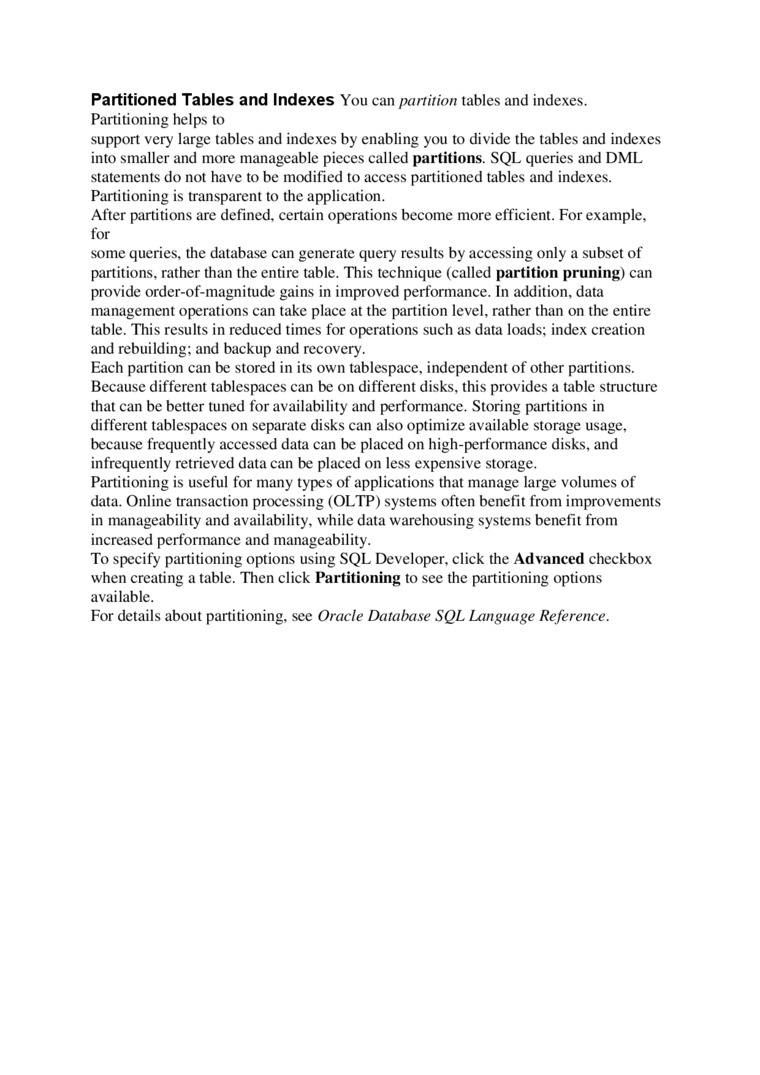79898

Partitioned Tables and lndexes You can partition tables and indexes. Partitioning helps to
support very large tables and indexcs by enabling you to divide the tables and indexes into smaller and morę manageable pieces called partitions. SQL queries and DML statements do not have to be modified to access partitioned tables and indexes. Partitioning is transparent to the application.
After partitions are defined, certain operations become morę efficient. For cxample, for
some queries, the database can generate query results by accessing only a subset of partitions, rather than the entire tablc. This technique (called partition pruning) can provide order-of-magnitudc gains in improved performance. In addition, data managemcnt operations can takc place at the partition lcvel, rather than on the entire tablc. This results in rcduccd times for operations such as data loads: index creation and rebuilding; and backup and recovery.
Each partition can be stored in its own tablespacc, independent of other partitions. Becausc different tablcspaces can be on different disks, this provides a table structurc that can be better tuned for availability and performance. Storing partitions in different tablespaces on separate disks can also optimize available storage usage, because frequently accessed data can be placed on high-performance disks, and infrequently retrieved data can be placed on less expensive storage.
Partitioning is useful for many types of applications that manage large volumes of data. Online transaction processing (OLTP) systems often benefit from improvements in manageability and availability, while data warehousing systems benefit from incrcased performance and manageability.
To spccify partitioning options using SQL Developcr. click the Advanced chcckbox when creating a tablc. Then click Partitioning to sec the partitioning options available.
For details about partitioning, sec Oracle Database SQL Language Reference.
Wyszukiwarka
Podobne podstrony:
Wrapping paper and tags Who needs expensive giossy paper when you can design your owo? Weil — łt’s n
o161 YOU CAN L£AV£ MB ON THB BBR TO PR£V£NT M£ PROM BSCAPINS 3HOULRNT yOU BB A BIT
rqe Start hercHelp!!! The State animal has run off!You can help... draw a path through the maże to h
42644 o161 YOU CAN L£AV£ MB ON THB BBR TO PR£V£NT M£ PROM BSCAPINS 3HOULRNT yOU BB A
Viewing Undo Information You can usc the Undo Management Details page to view the following informat
qer Start hercNow where did I put that Oregon flag?You can help... draw a path through the maże to h
Włiat Are Disk Properties You can use either Disk Management or DiskPart to view disk properties, wh
Nonpartitioned and Partitioned As with tables, you can partition an index. In most situations, it is
Autoextend Tablespace You can set a tablespace to automatically extcnd itself by a spccified amount
Creating a Tablespace You can creatc additional tablcspaccs to storę user data, so that not all data
Space Needed for Keys My ISAM tables use B-tree indexes. You can roughly calculate the size for the
primary partition cannot be subdivided. An extended partition can be divided into logical drive
f5 7 Ł1 Roadmap Resources ♦ Home Paae f+1 Amusements Search engines and sites where you can downloa
Slide5 PRODUCE IT See the information in English (or picture) and think or say it in Polish You can
2.3.8.3. LAN Here you can find LAN-related information like active clients and DHCP clients. 2.3.8.4
Bndging By default, one bridge (brO) is defined and active. In this section you can define additiona
Download Geometria del piano PDF eBooks Free suggestion is that you can wind up there, too - and you
więcej podobnych podstron